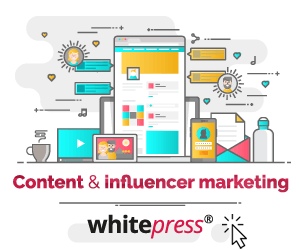One of the aspects of blogging is to make not only fun out of it but also to make money. It comes as no surprise that bloggers think about monetising their efforts, and brands are increasingly more interested in using bloggers as brand ambassadors: especially, if you take into account bloggers’ reach, influence and opportunities to shine on social media.
Numbers speak for themselves: the survey conducted by Collective Bias shows that 30% of consumers are more likely to trust recommendations coming from a non-celebrity blogger, as they can relate more to them and appreciate their opinions.

This is a win-win-win for all of the three parties: a blogger gets money and opportunity to show products or services, a brand gets a natural recommendation, and a target group gets information about the product they were looking for.
Brands used to buy sponsored articles at websites or blogs. Today, we are going to reveal every secret of a sponsored article so you would know how to make it your blessing rather than a curse.
What is a sponsored article?
A sponsored article is a piece of content (not only a plain text but also photos, videos, animations, photo shoots and other, non-standard forms) that is published in a selected medium: blog, vlog, social media, website; depending on many factors, including the shape of the article. A word „sponsored” stands for paid collaboration: a particular piece of content is sponsored/paid for by brands who deliver products, services and fee to a selected website or blogger. The collaboration fee can be money or products – so-called barter. The rules of cooperation are often discussed individually, and there is no universal pricing for each website or brand.

What is the goal?
There are a few reasons brands decide on buying sponsored content:
- brand awareness – they want to be more recognised within target groups
- driving sales – they regard sponsored articles as sales support
- increasing visibility – they want to improve their position in Google search results
- the buzz around the brand / a particular campaign
What are types of sponsored articles?
The sponsored article does not have to be a plain article. There are many forms you can use or offer if you have an influential position.
A long post
It can be a blog post, a press release, a listicle, an interview or a report. It is often enhanced and combined with photo gallery, video clips, infographics. The video equivalent of it is just a longer video.
A short post
It can be published in the form of a shorter post, sneak peek (a sort of a “teaser”, a short text form to get familiar with before something is officially available or published) or social media post.
A series of posts
Sometimes brands get into collaboration based on a few posts published in a specific period, by one or more bloggers. The series usually concern the same topic from different points of view.
A multimedia post
Brands are more and more willing to go the extra mile for their target groups, and they are trying to spoil them with more interactive, out-of-the-box content: video clips, infographics, slideshows or quizzes.
A social media publication
Some influencers charge extra, or just a different fee, for a short social media mention on, for instance, Instagram Stories. This kind of publication is only limited to a chosen platform’s native features.

Sometimes brands select a type of posts no matter what the price or terms of collaboration are. Articles can be a part of a more extensive campaign, and they would have to follow a particular path. They can be a campaign itself, too.
However, there are a few factors that need to be taken into consideration both for figuring out how much to charge, and how much to pay.
What impacts the price of sponsored articles?
Reach.
If a selected blog or website has a high number of monthly Unique Users within the desired group, they may charge a lot for a sponsored entry. However, brands should not take only this one factor into account, as there are more to investigate.
Influence.
How influential is that blogger, what kind of community is built around the website? What about people, who stand behind the project? Is their personal branding impacting the success of a blog? Widely known people may charge more for publications if they promise to share it with their network and they have a vast following themselves.
Subjectivity.
Does a particular website cover any niches? Even if the site is small-ish but tightly targeted to a specific group, they are entitled to charge more and be pickier as for the sort of publications brands would like to put there. Also, if there are not many similar pages to that one on the Internet, and a brand cares about their exposure there, the owners of the website can sell articles for serious money.
Target group.
Promoting a product for athletes may not go well on a parenting blog, a fashion blogger’s audience may not be interested in a historical campaign, a technical geek won’t sell mascaras (probably! You are more than welcome to try it out, though). Sponsored articles can achieve success only if they are read by target groups who can take the desired action.

Commercial exploit.
This is a factor that is often missed or avoided by brands, even if it should be among the first ones to focus on! Influencer marketing is getting so popular that well-known bloggers have quite a few projects in their portfolios already. It is worth checking if a particular blogger has already cooperated with competitors, has some similar plans they took part in or directly, if they are very much into advertising – or if they promote stuff rarely. This should be considered by bloggers, too – if they already have a few commercial projects that were highly successful, they may be willing to charge more for their services.
Brand’s reputation.
Let’s face it – there are some brands whose marketing life is just more comfortable, they are widely recognised and loved – so-called „love brands” like Coke, BMW or Netflix. Bloggers invited to such a campaign are truly spoilt – not only they can earn good money, but also become famous because of the campaign. Having a project like this is a real prestige for chosen bloggers.
Experience.
If a particular blogger or website is famous for their publications for a while now, and they have an established market position, they may charge more for publications and articles. If they are newbies in this business, they may not be experienced enough to charge a lot and to estimate their work correctly: they may both underestimate or overestimate.
Social media channels.
This point is essential if a sponsored content should be additionally promoted on social media platforms. Using social media reach of chosen influencers can help brands reach wider audiences. There is a tip for bloggers, too – if you gathered quite a few followers who are engaged and happy to interact with your content, you may think about adding this to your services for additional fee.
Extras.
If a sponsored article goes out-of-the-box (for example, requires making a contest), the price may change and cover contest preparation’s expenses.
The amount of work.
Does brand deliver a ready-to-go article, a brief or just a title for a blogger to work on it? Does it require a seller to do further research, or they only offer an advertising place? This matter should not be omitted and can visibly influence the final price.
Statistics.
Blog, website and social media reach counts, but as a party who buys an article, you should also check metrics such as Trust Flow or Google Visibility, available in tools like Moz, Ahrefs, Majestic or Clusteric.
The checklist we provided is long, but both sellers: websites, bloggers, influencers – and buyers: brands, should go through it to ensure the best ratio between price and quality.
What are sponsored articles for?
There are no limits as for who can buy sponsored articles, and this practice is seen by many brands who would like to achieve their business goals. However, we can identify a few main groups.
- Thanks to advanced tracking options and possibilities of measuring the impact of articles in real time, e-commerce is one of those industries who are the most interested in purchasing sponsored articles.
- FMCG – sponsored articles in this industry impact on sales and recognition, and help with building trust.
- The technology sector, represented in sponsored articles by tech geeks, can benefit from articles and drive sales.
- Launching new products or services can be supported by publishing sponsored articles.
Do you run a business in a different industry? No worries, sponsored articles can be a way to go for you as well.

How to find a place to buy a sponsored article from?
Let’s say, in the world of online fraud and fake likes, finding a pearl to publish sponsored articles is not a cakewalk. There are a few ways of finding an excellent place for publishing (and offering your reach as a blogger/website!):
- Manual harvest – you are simply looking on Google and verifying manually if your finding is a good match with your brand
- Aggregators – in some tools, such as Whitepress.net, you can set up desired settings and let the platform do it for you – choose the best fits. There are quite a few tools like this on the market.
- Recommendation – some people say nothing works better than this! Ask your fellow marketers where they put their content and what sources brought them real effects. You may use the same sources or get inspired.
- Groups – join some Facebook groups for marketers, bloggers and influencers. They seem to offer their services when the context is right. Obviously, you still need to check them if it is something you seek, but at least you will have a useful list to start with!
There is no universal answer as for the cost of sponsored articles. Some would prefer buying ten articles for $10 each; others would decide on buying one, but for $100. Many factors are determining a final price, and they should always be taken seriously.









